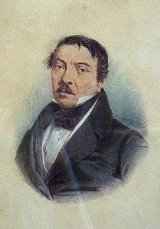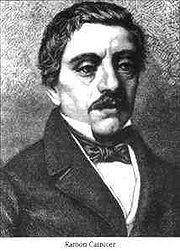
Ramón Carnicer
Encyclopedia
Ramon Carnicer i Batlle was a Catalan
composer and opera conductor, today best known for composing the National Anthem of Chile.
Carnicer was born in Tàrrega
, Catalonia
(Spain). His first major positions were as conductor for the opera
, and he was influential in the development of the Spanish national opera style, zarzuela
. He conducted the Italian Opera in Barcelona
from 1818 to 1820, and the Royal Opera
in Madrid
from 1828 to 1830, as well as composing nine operas.
 In 1830, he accepted a position as professor of composition at the Madrid Conservatory
In 1830, he accepted a position as professor of composition at the Madrid Conservatory
, which he would retain until his retirement in 1854. He composed a variety of songs, church music, and symphonies; his best-remembered composition today being the National Anthem of Chile. He died in Madrid in 1855.
Catalan people
The Catalans or Catalonians are the people from, or with origins in, Catalonia that form a historical nationality in Spain. The inhabitants of the adjacent portion of southern France are sometimes included in this definition...
composer and opera conductor, today best known for composing the National Anthem of Chile.
Carnicer was born in Tàrrega
Tàrrega
Tàrrega is a village and municipality located in the Urgell comarca, province of Lleida, Catalonia. According to the 2009 census , the village has a population of 16.539 inhabitants....
, Catalonia
Catalonia
Catalonia is an autonomous community in northeastern Spain, with the official status of a "nationality" of Spain. Catalonia comprises four provinces: Barcelona, Girona, Lleida, and Tarragona. Its capital and largest city is Barcelona. Catalonia covers an area of 32,114 km² and has an...
(Spain). His first major positions were as conductor for the opera
Opera
Opera is an art form in which singers and musicians perform a dramatic work combining text and musical score, usually in a theatrical setting. Opera incorporates many of the elements of spoken theatre, such as acting, scenery, and costumes and sometimes includes dance...
, and he was influential in the development of the Spanish national opera style, zarzuela
Zarzuela
Zarzuela is a Spanish lyric-dramatic genre that alternates between spoken and sung scenes, the latter incorporating operatic and popular song, as well as dance...
. He conducted the Italian Opera in Barcelona
Barcelona
Barcelona is the second largest city in Spain after Madrid, and the capital of Catalonia, with a population of 1,621,537 within its administrative limits on a land area of...
from 1818 to 1820, and the Royal Opera
Teatro Real
The Teatro Real or simply El Real , is a major opera house located in Madrid, Spain.-History:...
in Madrid
Madrid
Madrid is the capital and largest city of Spain. The population of the city is roughly 3.3 million and the entire population of the Madrid metropolitan area is calculated to be 6.271 million. It is the third largest city in the European Union, after London and Berlin, and its metropolitan...
from 1828 to 1830, as well as composing nine operas.

Madrid Conservatory
-History:The Royal Conservatory of Music was founded on July 15, 1830, by royal decree, and was originally located in Mostenses Square, Madrid. In 1852 it was moved to the Royal Opera, where it remained until the building was condemned by royal order and classes ordered to halt in 1925. For the...
, which he would retain until his retirement in 1854. He composed a variety of songs, church music, and symphonies; his best-remembered composition today being the National Anthem of Chile. He died in Madrid in 1855.
Opera
(Some of his operas are lost but we now about them thanks to some references from the documents of his period. It's also not 100% clear that three or four of these pieces were written by Carnicer)- Adele di Lusignano: Melodramma semiserio (1819), Opera in Italian, in two acts
- Elena e Costantino: Dramma eroico-comico in due atti (1821, premiered again in 2005), Opera in Italian, libretto by Andrea Leone Tottola
- Il dissoluto punito, ossia Don Giovanni Tenorio (1822, premiered again in 2006), Opera in Italian, in two acts, libretto by Giovanni Bertati.
- Elena e Malvina (1827), Opera in two acts
- Cristoforo Colombo (1829), Opera
- Eufemio di Messina (1832), Opera
- Guglielmo Tell (1834), Opera
- Eran due or sono tre, o sea, Gli esposti (1836), Opera bufa in two acts. Libretto by Jacopo Ferretti
- Ismalia o Morte ed amore (1838), Opera in two acts
- Laura y Don Gonzalo (1841), òpera in 4 acts. Music attributed to Carnicer. Libretto attributed to Manuel Bretón de los Herreros
- Ipermestra (1843), drama in three acts. Words by Pietro Metastasio. Authorship discussed
- Lucrezia Borgia. Attributed opera, some believe he had only collaborated in the composition
- El sacristán de Toledo, Opera. It's said he had only collaborated composing incidental music
Instrumental
- Fantasía en mi bemol mayor, for clarinet
- Gran sinfonía en Re (1839)
- Fantasía original para clarinete con acompañamiento de piano (1849)
- Capricho para contrabajo con acompañamiento de piano (1852) (Capricho for doublebass with piano accompaniment)
- Melodía fantástica con acompañamiento de piano
- Sinfonía oriental
- Solo de flauta (solo for flute)
- Salmòdia for organ
- 6 Sonates per a instrument de tecla
- Obertura (sinfonía) Composed for the premier of the opera Il barbiere di Siviglia by Rossini in Barcelona (1818)
- A second overturefor that same opera
Vocal
- El caramba: canción andaluza (ca. 1832), Voice and piano or guitar
- Completas Fratres a 4 v., 4 voices, 6 instruments, accompaniment and continuo
- La criada: canción española (ca. 1832), voice, guitar and piano
- El currillo: canción andaluza (ca. 1835), voice, guitar and piano
- La gitanilla (ca. 1831), song for voice, guitar and piano
- Himno a los defensores de Gandesa (1838).
- Himno patrio de la República de Chile (1828)
- Himno patriótico, con motivo de la publicación del Estatuto Real (1834)
- Himno patriótico [para el] cumpleaños de la Reina Doña Isabel II (1835)
- El julepe: polo (1823), song for voice and guitar
- Misa de Réquiem (1929), 4 voices and orchestra, in Latin. For Maria Josepa from Saxonia, Ferran VII therd wife
- Misa de Réquiem (1842), 4 voices and orchestra, in Latin
- Misa solemne (entre 1806 i 1808), 8 voices and orchestra
- El músico y el poeta (Los maestros de la Raboso), tonadillaTonadillaTonadilla was a Spanish musical song form of theatrical origin; not danced. The genre was a type of short, satirical musical comedy popular in 18th-century Spain, and later in Cuba and other Spanish colonial countries. It originated as a song type, then dialogue for characters was written into the...
a dúo - El no sé, song for voice, guitar and piano
- La noticia feliz: polo y seguidillas (1823), song for voice, guitar and piano
- El nuevo sereni (1825), song for voice, guitar and piano or guitar
- Odas de Anacreonte (1832), text original grec d'Anacreont i traducció castellana de José del Castillo y Ayensa, comprèn les cançons per a veu i piano De si mismo, A una muchacha i Del amor y la abeja
- El poder de las mugeres: canción española con acompañamiento de piano y guitarra (1836)
- Psalmodia que contiene todos los tonos (1818)
- Tantum Ergo
- Tonadilla de la cantinera (1813)
- Vigilias con orquesta para las exequias de Fernando VII (1833), in Latin
- El chairo: canción española cantada en la ópera "El barbero de Sevilla" (1833), lyrics by Agustín Azcona

